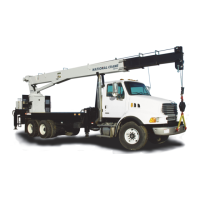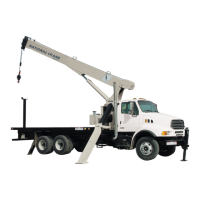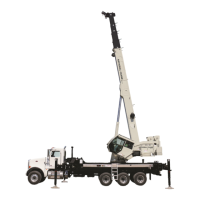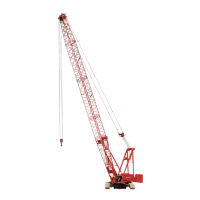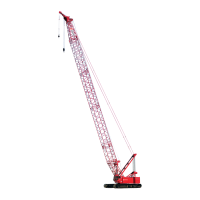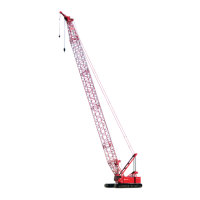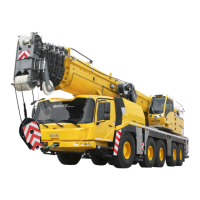National Crane Published 10-30-2014 Control # 040-09 3-5
1400H OPERATOR AND SERVICE MANUAL MAINTENANCE
• In rotation resistant ropes: two randomly distributed
broken wires in six rope diameters or four randomly
distributed broken wires in 30 rope diameters
• Wear of one-third the original diameter of outside
individual wires. Worn rope, usually indicated by flat
spots on the outer wires is unsafe for further use when
less than two-thirds the thickness of the outer wire
remains.
• Necking down of the rope indicates core failure.
• Kinking, crushing, bird caging, or any other damage
resulting in distortion of the rope structure.
• Evidence of heat damage.
• Reductions from nominal diameter of more than 5%:
- 0.0156 in (.4 mm) for rope diameters to 0.313 in (8
mm)
- 0.031 (.8 mm) for rope diameters 0.375 in (9.5 mm)
to 0.50 in (12.7 mm)
- 0.047 in (1.2 mm) for rope diameters 0.561 in (14.3
mm) to 0.75 in (19.1 mm)
- 0.063 (1.6 mm) for rope diameters 0.875 in (22.2
mm) to 1.125 in (28.6 mm).
• One outer wire broken at its point of contact with the core
of the rope which has worked its way out of, and
protrudes or loops out from the rope structure.
• n standing ropes, more than two broken wires in one lay
in sections beyond end connections or more than one
broken wire at an end connection.
• National recommends that for cable extended booms, a
single damaged wire rope assembly shall require
replacement of the complete set of extension cables.
• National recommends that boom extension cables be
replaced every seven (7) years.
Care of Wire Rope
Handle wire rope with care to prevent damage to the
individual wires which affect the overall strength and
performance of the rope. Do not allow the formation of kinks,
because this displaces the strands of wire from their original
position and relation to each other causing severe bending
and unequal tensions in the strands. This distortion and wire
displacement cannot be corrected even under high tension
and a permanent weak point remains in the rope. Displaced
or raised wires indicate a previous kink, but does not show
the damaged condition of the inner rope wires.
Never pull wire rope over a non-rotating support such as a
spindle bar, a pin, or an inoperative sheave. This practice
causes severe abrasion to the outer strand wires. A properly
operating sheave or snatch block is essential to safety and
long service life of the rope.
Do not use worn sheaves or sheaves with flat grooves
because they do not provide sufficient support to prevent the
distortion and flattening of the rope. Sheaves with nicked or
broken flanges can cut or otherwise damage the rope.
An even distribution of rope coils over the hoist drum is
essential to smooth operation. This prevents the rope from
cutting down through or crushing other coils on the drum
resulting in damage to and difficulty in unwinding the rope.
Rope Construction
If wire rope replacement is required for crane extension
system, replacement ropes must be obtained through The
National Crane Product Support Department. Extension
ropes are prestretched and have special connections for
proper operation.
Standard
5/8 in Dia. Wire Rope Rotation Resistant
(Main and Auxiliary Hoist) Nominal Breaking
Strength 22.7 tons
Optional
5/8 in Dia. Wire Rope 6x25 General purpose
(Main and Auxiliary Hoist) Nominal Breaking
Strength 20.6 tons
If wire rope replacement is required for crane loadline,
care should be taken in selecting a wire rope suitable for
crane use. Wire rope strength requirements are shown on
the crane capacity chart to match the hoist option selected
when the crane was purchased. Rope construction required
is optional with 6 x 25 and Dyform being the most common
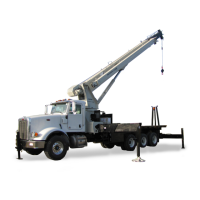
